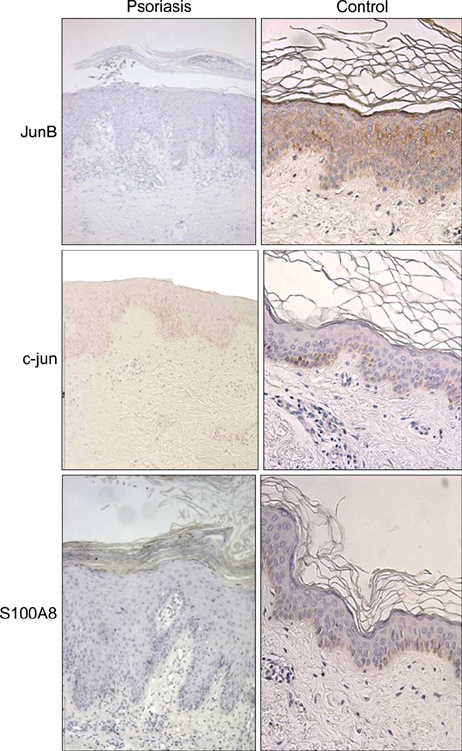Ann Dermatol.
2009 Feb;21(1):35-38. 10.5021/ad.2009.21.1.35.
Comparison of the Expression Profile of JunB, c-Jun, and S100A8 (Calgranulin A) in Psoriasis Vulgaris and Guttate Psoriasis
- Affiliations
-
- 1Department of Dermatology, College of Medicine, The Catholic University of Korea, Seoul, Korea. beauty4u@catholic.ac.kr
- 2Department of Microbiology, School of Medicine, Ewha Womans University, Seoul, Korea.
- KMID: 2172062
- DOI: http://doi.org/10.5021/ad.2009.21.1.35
Abstract
- BACKGROUND
Psoriasis is a chronic, inflammatory, immune- mediated skin disease. Recently, several psoriasis-linked genetic loci have been reported; PSORS4 contains S100A8 (calgranulin A), and PSOR6 (19p13) locus harbors JunB (19p13.2). S100A8 is considered to be a marker of inflammation in a variety of diseases. The expression of JunB and c-Jun have been reported to be reduced in psoriatic lesions.
OBJECTIVE
We attempted to assess the role and correlation of S100A8, JunB, and c-Jun in the pathogenesis of guttate psoriasis and psoriasis vulgaris by studying whether any difference of immunohistochemical expression existed.
METHODS
Skin biopsy specimens from patients with psoriasis vulgaris (n=37) and guttate psoriasis (n=17), and a normal skin controls (n=9) were utilized in the study. Formalin-fixed and paraffin-embedded tissue sections were prepared and JunB, c-Jun, and calgranulin A were immunohistochemically stained in order to compare the expression of those three proteins in each group.
RESULTS
Reduced JunB expression was observed in patients with psoriasis vulgaris and guttate psoriasis, as compared to patients in the control group; however, c-Jun expression was reduced only in the psoriasis vulgaris group. The expression of S100A8 increased in the psoriasis groups as compared to the control group. In addition, the expression of S100A8 was different between the psoriasis vulgaris and guttate psoriasis groups; S100A8 was expressed more profoundly in the guttate psoriasis group (p<0.05).
CONCLUSION
Our results indicate that S100A8 contributes to the pathogenesis of guttate psoriasis, and it may be a good target for therapy for guttate psoriasis provoked by microorganisms.
MeSH Terms
Figure
Reference
-
1. Bowcock AM, Krueger JG. Getting under the skin: the immunogenetics of psoriasis. Nat Rev Immunol. 2005. 5:699–711.
Article2. Pouliot P, Plante I, Raquil MA, Tessier PA, Olivier M. Myeloid-related proteins rapidly modulate macrophage nitric oxide production during innate immune response. J Immunol. 2008. 181:3595–3601.
Article3. Zenz R, Eferl R, Kenner L, Florin L, Hummerich L, Mehic D, et al. Psoriasis-like skin disease and arthritis caused by inducible epidermal deletion of Jun proteins. Nature. 2005. 437:369–375.
Article4. Youn JI, Jo SJ. Clinical study on 3,123 psoriatic patients: observation of the patients registered for the past 20 years (1982~2002) at Seoul National University Hospital Psoriasis Clinic. Korean J Dermatol. 2004. 42:1536–1542.5. Martin BA, Chalmers RJ, Telfer NR. How great is the risk of further psoriasis following a single episode of acute guttate psoriasis? Arch Dermatol. 1996. 132:717–718.
Article6. Foell D, Wittkowski H, Vogl T, Roth J. S100 proteins expressed in phagocytes: a novel group of damage-associated molecular pattern molecules. J Leukoc Biol. 2007. 81:28–37.
Article7. Christophers E. Explaining phenotype heterogeneity in patients with psoriasis. Br J Dermatol. 2008. 158:437–441.
Article
- Full Text Links
- Actions
-
Cited
- CITED
-
- Close
- Share
- Similar articles
-
- A Case of Tonsillectomy as a Treatment of Guttate Psoriasis
- A Case of Guttate Psoriasis after Treatment with IFN-alpha
- Linear Psoriasis Localized on Unilateral Arm - A Rare Variant of Psoriasis
- Comparison of Th1 and Th17 Inflammatory Cytokine Profiles Between Chronic Plaque and Acute Guttate Psoriasis
- Infliximab: Effective Therapy for Pustular Psoriasis



